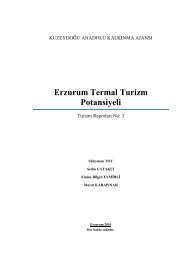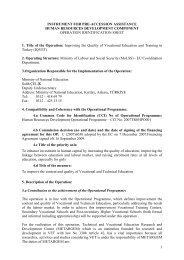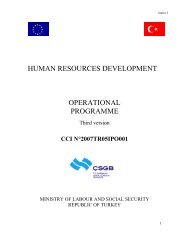ANNEX XXI - (HRD OS) > Home
ANNEX XXI - (HRD OS) > Home
ANNEX XXI - (HRD OS) > Home
You also want an ePaper? Increase the reach of your titles
YUMPU automatically turns print PDFs into web optimized ePapers that Google loves.
• Discouraged persons,<br />
• Nomads,<br />
• Other disadvantaged persons as appropriate (i.e. drug addicts, victims of domestic<br />
violence, parents of working children, temporary/seasonal workers especially in<br />
agriculture, children who are implicated in a crime and their families),<br />
• Employers and other employees at the workplace,<br />
• Staff of İŞKUR, other relevant institutions and NGOs.<br />
5.7 Description of the Operation and background:<br />
According to the 2009 Poverty Study conducted by TURKSTAT based on Household Budget<br />
Survey results, poverty rate is 18, 08 percent, which corresponds to 12.7 million people, in<br />
Turkey. Poverty is more widespread in rural areas (38, 69 percent) than in urban areas (8, 86<br />
percent). Poverty increases with household size and especially with the number of dependent<br />
children and decreases as education level increases. Parallel to the cross-country evidence,<br />
poverty rate is the lowest (6, 05 percent) among wage/salary earners and the highest among the<br />
unemployed (19, 51 percent).<br />
Although poverty is closely related with social exclusion, social exclusion represents a more<br />
comprehensive approach where both monetary and non-monetary factors are taken into<br />
consideration. For instance, although a poor person is more likely to be socially excluded, a<br />
socially excluded person does not have to be poor. An example may be a disabled person who is<br />
socially excluded due to reasons other than poverty (such as physical reasons, prejudices against<br />
them or having less chances in life due to low access to education). Thus, it may be argued that<br />
social exclusion has a wider perspective than monetary poverty in explaining people’s living<br />
conditions and difficulties that they face.<br />
Therefore, by and large, target groups of this Operation are those who are poor, at risk of poverty<br />
and/or socially excluded. Although the needs of target groups referred in section 5.6 above<br />
differ, it is well known that common characteristics of all disadvantaged persons are being poor<br />
or at risk of poverty resulted primarily by low chances of being employed, living in gecekondu<br />
areas, working in unregistered and/or temporary jobs and having low education and skills.<br />
Therefore, active labour market policies that would support their access to labour market should<br />
be at the centre of an attempt to ensure their inclusion in the social life. Unlike other unemployed<br />
4









